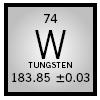Tungsten

MELTING POINT:
3,422 ± 15°C
BOILING POINT:
5,700 ± 200°C
DENSITY:
19.3 g/cm
3
MOST COMMON IONS:
WO
4
2−
Tungsten is a metallic transition element in Period 6, Group 6 of the Periodic Table. It was first described in 1783 by Spanish brothers Juan Jose and Fausto de Elhuyar. They named the element Wolfram after a term used by the ancient tin miners in Saxony-Bohemia, describing a still unknown mineral. The name was later changed to tungsten, derived from the Swedish words tung and sten (meaning "heavy stone").
Tungsten has a silvery-white luster and is brittle at room temperature. At elevated temperatures (100°–500°C [212°–932°F]), it is transformed into the ductile state. Tungsten metal is stable in air only at moderate temperatures; all high-temperature applications are therefore limited to a protective atmosphere or vacuum.
Thirty-five isotopes of tungsten are known; five of them are naturally occurring (180, 182, 183, 184, and 186). In nature, tungsten occurs only in a chemically combined state, mainly as tungstate. The most important tungsten minerals are: scheelite (CaWO 4 ), wolframite (Fe, MnWO 4 ), ferberite (FeWO 4 ), and huebnerite (MnWO 4 ). The average abundance in Earth's crust is 1.3 μ g/g [1.3 ppm].
Tungsten and tungsten alloy products are used in lighting (in the form of wires, coils, and coiled coils in incandescent lamps, and as electrodes in discharge lamps), electrical engineering (high-performance switches), electronics (integrated circuits), medical engineering (x-ray targets), sport equipment (golf club components), aviation and military components (tank ammunition), and steel technology (high-speed steels). Tungsten carbide (WC) forms the main constituent in cemented carbides (also known as hard-metals); these very hard and tough materials are used for metal cutting, machining of wood, plastics and composites, mining tools, construction and wear parts, and military components. Oxides are used as phosphors, pigments, catalysts (oil industry, combustion plants), and electrochromic devices (smart windows).
Wolf-Dieter Schubert
Burghard Zeiler
Bibliography
Lassner, Erik, and Schubert, Wolf-Dieter (1996). "Tungsten, Tungsten Alloys, and Tungsten Compounds." Ullmann's Encyclopedia of Industrial Chemistry, Vol. A27. Weinheim, Germany: VCH Verlagsgesellschaft mbH.
Lassner, Erik, and Schubert, Wolf-Dieter (1999). Tungsten: Properties, Chemistry, Technology of the Element, Alloys, and Chemical Compounds. New York: Kluwer Academic/Plenum Publishers.
Comment about this article, ask questions, or add new information about this topic: